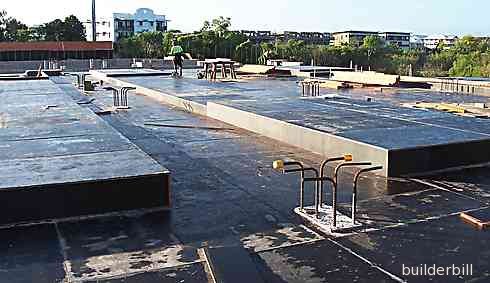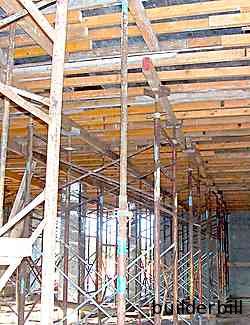 |
|||||
Graphical Construction Glossary >> Formwork. >> formwork >> Concrete Formwork
Traditionally the material used to construct and support the forms or shuttering for concrete has been timber. However new materials and techniques are being used all the time, but it would be fair to say that timber and plywood as seen in the photos on this page is still the main method for general contracting. Above, form work being prepared for a suspended slab on a multi-story building. In this case it consists of formply on timber joists and proprietary metal props. When the carpenters have finished and before the rebar is placed the formply is treated with form oil. Release Oil Should not be home made (the author has seen various recipes including the use of waste sump oil) as it can leave unsightly stains. It is often sprayed onto the surface with a backpack spray. In this case care should be taken not to contaminate nearby rebar with over spray. At the right is the underside of the same slab showing the system of supporting the concrete formwork, and more importantly the rebar and wet concrete until the concrete has set or cured. For non glossary articles of a general and how to nature go to the formwork section on this site. If you didn't find exactly what you are looking for try this search tool that will search the site and the web. "What can be added to the happiness of a man who is in health, out of debt, and has a clear conscience? "When we build, let us think that we build for ever."John Ruskin 1819-1900 |
Hire Equipment  Furniture Fittings - Architectural Hardware - Electronic Locking Systems - Technical Hardware BuilderBill sponsorship Glossary Pages.Roof Glossary and Roofing Formwork Glossary and other tempory work. Hand Tools Glossary Power Tools Glossary Asbestos Glossary Woodwork Glossary Stair Glossary Concrete Glossary Masonry Glossary doors Glossary BuilderBill Books Building Maths  Stair Design  Asbestos Book |
||||
|
|
|||||
|
Please Note! The information on this site is offered as a guide only! When we are talking about areas where building regulations or safety regulations could exist,the information here could be wrong for your area. It could be out of date! Regulations breed faster than rabbits! You must check your own local conditions. Copyright © Bill Bradley 2007-2012. All rights reserved. |
|||||

